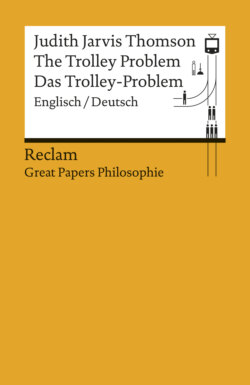Читать книгу The Trolley Problem / Das Trolley-Problem (Englisch/Deutsch) - Judith Jarvis Thomson - Страница 10
На сайте Литреса книга снята с продажи.
VI.
ОглавлениеAs I said, my own feeling is that the trolley problem can be solved only by appeal to the concept of a right – but not by appeal to it in as simple a way as that discussed in the preceding section. What we were attending to [1407] in the preceding section was only the fact that the agents would be killing and saving if they proceeded; what we should be attending to is the means by which they would kill and save.12 [54](It is very tempting, because so much simpler, to regard a human act as a solid nugget, without internal structure, and to try to trace its moral value to the shape of its surface, as it were. The trolley problem seems to me to bring home that that will not do.)
I said earlier that there seem to me to be two crucial facts about what the bystander does if he proceeds in Bystander at the Switch. In the first place, he saves his five by making something that threatens them instead threaten the one. And second, he does not do that by means which themselves constitute infringements of any right of the one’s.
Let us begin with the first.
If the surgeon proceeds in Transplant, he plainly does not save his five by making something that threatens them instead threaten one. It is organ-failure that threatens his five, and it is not that which he makes threaten the young man if he proceeds.
Consider another of Mrs. Foot’s cases, which I shall call Hospital.
Suppose [Mrs. Foot says] that there are five patients in a hospital whose lives could be saved by the manufacture [56]of a certain gas, but that this will inevitably release lethal fumes into the room of another patient whom for some reason we are unable to move.13
Surely it would not be permissible for us to manufacture the gas.
In Transplant and Hospital, the five at risk are at risk from their ailments, and this might be thought to make a difference. Let us by-pass it. In a variant on Hospital – which I shall call Hospital’ – all six patients are convalescing. The five at risk are at risk, not from their ailments, but from the ceiling of their room, which is about to fall on them. We can prevent this by pumping on a ceiling-support-mechanism; but doing so will inevitably release lethal fumes into the room of the sixth. Here too it is plain we may not proceed.
[58]Contrast a case in which lethal fumes are being released by the heating [1408] system in the basement of a building next door to the hospital. They are headed towards the room of five. We can deflect them towards the room of one. Would that be permissible? I should think it would be – the case seems to be in all relevant respects like Bystander at the Switch.
In Bystander at the Switch, something threatens five, and if the agent proceeds, he saves the five by making that very thing threaten the one instead of the five. That is not true of the agents in Hospital’ or Hospital or Transplant. In Hospital’, for example, what threatens the five is the ceiling, and the agent does not save them by making it threaten the one, he saves them by doing what will make something wholly different (some lethal fumes) threaten the one.
Why is this difference morally important? Other things being equal, to kill a man is to infringe his right to life, and we are therefore morally barred from killing. It is not enough to justify killing a person that if we do so, five others will be saved: To say that if we do so, five others will be saved is merely to say that utility will be maximized if we proceed, and that is not by itself sufficient to justify proceeding. Rights trump utilities. So if that is all that can be said in defense of killing a person, then killing that person is not permissible.
[60]But that five others will be saved is not all that can be said in defense of killing in Bystander at the Switch. The bystander who proceeds does not merely minimize the number of deaths which get caused: He minimizes the number of deaths which get caused by something that already threatens people, and that will cause deaths whatever the bystander does.
The bystander who proceeds does not make something be a threat to people which would otherwise not be a threat to anyone; he makes be a threat to fewer what is already a threat to more. We might speak here of a “distributive exemption,” which permits arranging that something that will do harm anyway shall be better distributed than it otherwise would be – shall (in Bystander at the Switch) do harm to fewer rather than more. Not just any distributive intervention is permissible: It is not in general morally open to us to make one die so save five. But other things being equal, it is not morally required of us that we let a burden descend out of the blue onto five when we can make it instead descend onto one.
I do not find it clear why there should be an exemption for, and only for, making a burden which is descending onto five descend, instead, onto one. That there is seems to me very plausible, however. On the one hand, the agent [62]who acts under this exemption makes be a threat to one something that is already a threat to more, and thus something that will do harm whatever he does; on the other hand, the exemption seems to allow those acts which intuition tells us are clearly permissible, and to rule out those acts which intuition tells us are clearly impermissible. [1409]
